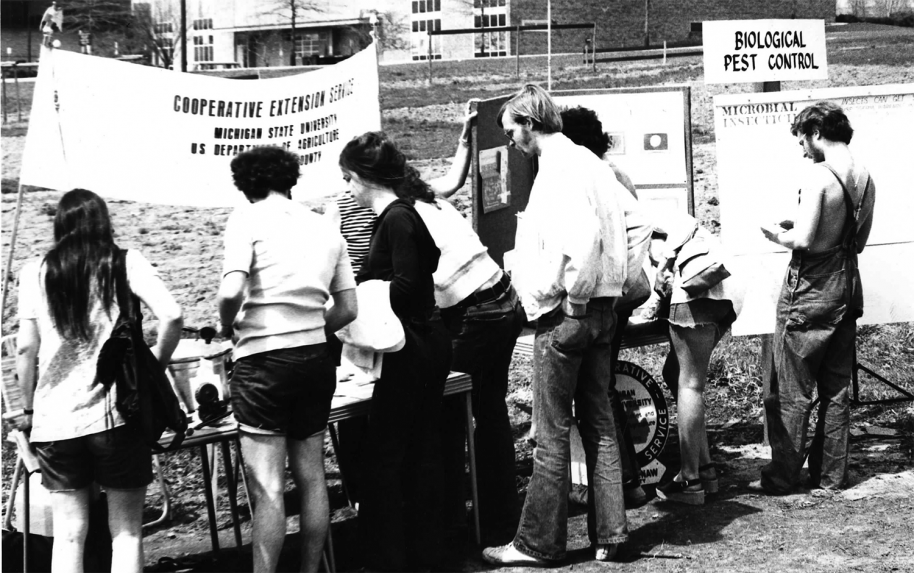One of 50 stories, from 50 years of action
From Beautiful on Paper to Beautiful Reality
In the spring of 1971, on a seven-acre site now occupied by the Gerald R. Ford Presidential Library, the Ecology Center began an organic garden. Established with seed money from the university, know-how and sweat equity from local volunteers, and donations from area businesses, the garden project had two goals. The first was becoming a showplace for “ecologically sound methods of agriculture” that demonstrated organic methods to farmers and home-owners who might otherwise think that chemical techniques were necessary for plant growth. Since it was a pilot project, the garden’s second goal prioritized community member engagement and learning. Organizers anticipated if this experimental garden was successful, other gardens around the city might also adopt organic techniques.
“The Garden is an experiment in living with the earth. It demonstrates that chemical-free, ecologically-sound gardening provides understanding for man’s relationship with the soil, the weather, plants, animals, and with himself. Those who have worked with and learned from the Garden are beginning to see the real possibility of actually living out low consumption lifestyles. We are glimpsing how we all fit together on this small planet.” from the Ann Arbor Community Organic Garden Information Sheet (April, 1972)

An Experiment in Living Sustainably with the Earth
As the world’s population continues to expand - and levels of consumption increase - there is pressure to “get more” out of the same amount of soil. The widespread adoption of synthetic fertilizers and pesticides in the decades following WWII allowed farmers to extract higher yields from their fields. At first glance, agricultural productivity and pest control might seem like no-brainers. Though easily applied and effective, chemical formulations like DDT -a widely-used pesticide- had systematically disastrous effects on local ecologies.
Rachel Carson’s book Silent Spring, published in 1962, brought the hazardous consequences of pesticide use to a national audience. Catalyzing a new wave of environmental awareness and action, Carson’s work motivated Americans to examine the impact of toxics used in food production. Her writing encouraged experiments throughout the US and around the world to break from a dependence on agricultural chemicals.
The Ann Arbor community garden drew its inspiration from a pioneer project at the University of California, Santa Cruz. Local citizens, U-M affiliates, and area farmers worked together throughout April 1972 to haul manure, build garden beds, and put up a tool shed. Over the following summer volunteers weeded, thinned, and mulched to transform the garden from being “beautiful on paper” to being a “beautiful reality.” Plantings of nearly all the vegetables that can be grown in Michigan stood in neat rows alongside demonstration plots of grapes, berries, and buckwheat. Beehives watched over several “home-sized” plots where volunteers learned how to manage garden projects and about diverse aspects of “man’s relation to his environment.”
National and Neighborhood Gardens
Bill Kopper, the EC’s first director, was “at the center” of the Ann Arbor Organic Garden Committee. The entire issue of Rodale's Environmental Action Bulletin in February 1972 was dedicated to Ann Arbor’s organic community garden and how it helped “define values which will correct the environmental inequities generated by a culture that does not understand what it is dependent on.”
The Bulletin emphasized that the community garden was much more than a vegetable plot. While organizers and volunteers discussed “the design of this year’s Community Garden” they also strategized “ways of working with food co-ops and aiding a county nutrition program[.]” Inspired by the article, during the following months letters from across the country arrived at the Ecology Center's office. Their pages were full of enthusiasm, questions, and proposals for similar projects in other cities. Here in southeast Michigan, for example, a recent survey of Detroit estimated that the city is home to 1400 community gardens. Whether in Ann Arbor, Detroit, or Santa Cruz, community gardeners expressed a commitment to cultivating healthy plants, promoting engagement with environmental issues, and practicing the same spirit of activism that established the Ecology Center.
While sharing suggestions with community groups around the country, the Ecology Center also looked to expand the gardening program locally. Funding from the US Department of Health, Education, and Welfare allowed Ecology Center staff to create educational materials for a series of “neighborhood satellite gardens.” These smaller gardens were distributed among the city’s neighborhoods and provided additional opportunities for involvement. Recognizing the potential for further expansion, the Ecology Center collaborated with Ann Arbor citizens and local governments to begin Project Grow - a non-profit organization that champions organic gardening throughout Ann Arbor.
Over the last fifty years community gardens have remained hubs for experiential learning. By applying knowledge to action, in this case through cultivating plants without pesticides, community members encounter first-hand the processes, challenges, and tasty results of organic gardening. Gardeners, volunteers, and learners represent the breadth of local communities. At Project Grow sites students worked alongside families, scout groups often lend a hand, and in one season a ninety-year-old man farmed three plots and shared the produce with his neighbors at Lurie Terrace, one of Ann Arbor’s senior housing communities.
Project Grow
Today there are twenty-two garden sites in the Ann Arbor area that host over 350 individual plots. Project Grow continues to make a positive impact in the community by donating fresh produce to local food organizations, such as Food Gatherers and the Safe House Domestic Violence Center, teaching classes about topics related to vegetable gardening, providing free plots for low income families, and by creating community partnerships with local schools, businesses, and government agencies.
Recalling the diversity of skills and resources that it took to start the first experimental garden, Project Grow remains committed to accessibility and collaboration. Residents from any neighborhood, of all ages, and with any level of expertise can garden. A wheelchair-accessible garden at the Center for Independent Living, raised beds at other Project Grow sites, and small “discovery gardens” for those who would like additional support, make gardening a possibility for the whole community.
Avoiding chemical fertilizers, reducing the use of environmental toxicants, and learning about the life-cycles of plants has broad implications beyond local communities. A report from the Intergovernmental Panel on Climate Change found that about a third of global emissions are attributable to agricultural activities (including the production of fertilizers and pesticides). Organic methods of food production have the potential to make a significant contribution toward climate sustainability. Whether tending a few herbs on a sunny kitchen windowsill, growing vegetables, or operating a commercial landscaping business, methods that promote healthy environments and healthy food are an important part of the solution - they help combat the climate crisis, build community resilience, and increase equity and justice.
To learn more about community gardening, visit Project Grow.
Each week this year we will be sharing one of 50 stories to celebrate 50 years of ongoing advocacy for healthy people and a healthy planet. Check back weekly for more, including further stories about land and food in Michigan that include the campaign to reduce pesticide use, collaborations to bring healthy food to hospitals and food banks, and the passage of an environmental bond measure.
Story Links:
- Ann Arbor Community Organic Garden
- Growing the Garden Movement
- Mike Schectman, former director of Ecology Center, discussing Project Grow
Created in partnership with the Environmental Justice HistoryLab at the University of Michigan. More Information.


